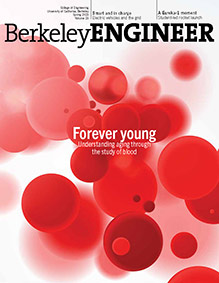 Photo courtesy Gridware
Photo courtesy GridwareOn the grid
Tim Barat (B.S.’19, M.S.’20 EECS) will never forget seeing the devastation caused by wildfires in his home state of Victoria, Australia. On Feb. 7, 2009 — a day now known as Black Saturday — 400 bushfires raged across more than 1,700 square miles, killing 173 people and destroying approximately 2,000 homes. Many fires were ignited by collapsed power lines, including the Kilmore East-Kinglake fire, which alone caused 120 deaths.
At the time, Barat was a high school dropout working as an electrical lineman, climbing power poles. When a power outage was reported, crew members would have to locate the faulty line, which sometimes required an 11-hour hike into the backcountry. Often, they would find fully energized lines sparking on the ground, dangerously close to dry vegetation.
The lack of a system to accurately detect power line failures confounded Barat. “We have sensors on our wrists, sensors in our pockets, all these incredible ways to sense the world,” said Barat. “And yet, if you have a power line failure, or you have a power line fall to the ground, often the utility doesn’t know that has happened.”
When Barat arrived at UC Berkeley in 2017, he was determined to develop a solution. Joining forces with classmates Hall Chen (B.S.’19 EECS) and Abdulrahman Bin Omar (M.S.’20 ChemE), Barat co-founded a startup, Gridware, to monitor telltale harmonics from power poles to evaluate electrical grid integrity and the potential hazard risks from power lines. Their device — called Gridscope — mounts to a power pole and detects anomalies using highly sensitive sensors, including a vibrometer and microphone. By continuously taking measurements at a rate of 6,000 times per second, it observes the grid’s environment, stress levels and equipment response. Any deviation from the expected behavior could indicate issues such as a strong wind blowing a line down or a car striking the post.
“Our technology feels the vibrations in the lines, listening to the very interesting and unique acoustic and vibration signals that are produced when these events occur,” said Barat. “For example, if you have vegetation hit a line, the line is going to be oscillating in a unique way. And those vibrations travel down through the pole, and we detect them.”
Gridscope uses analog and digital signal processing and an advanced analytics engine to then process the sensor data locally and determine what action to take, such as whether to report activity to utility managers.
The team credits co-founder and mentor Prabal Dutta, associate professor of electrical engineering and computer sciences, with helping optimize the technology. The CITRIS Foundry provided key support to help them secure funding and launch their startup.
Currently, Gridware anticipates producing 100,000 units by the end of 2023. According to Barat, most utilities on the West Coast that have a wildfire mitigation plan are either on the waitlist for Gridscope or have engaged with the company. And their efforts have not gone unnoticed. Gridscope was recognized by Time magazine as one of the best inventions of 2022, and Barat, Chen and Bin Omar were featured on Forbes’ “30 Under 30” list of top entrepreneurs.
For Barat, realizing his original vision has been incredibly rewarding — and an important reminder that everyone at Berkeley has the potential to make an impact, even a former high school dropout. “I stepped into EECS with a lot of self-doubt and a major case of imposter syndrome,” he said. “But if I could rewind and show myself just a glimpse of where we are now and what we’ve built, I think that would be incredibly encouraging.”
Learn more: Energized for real-world impact

